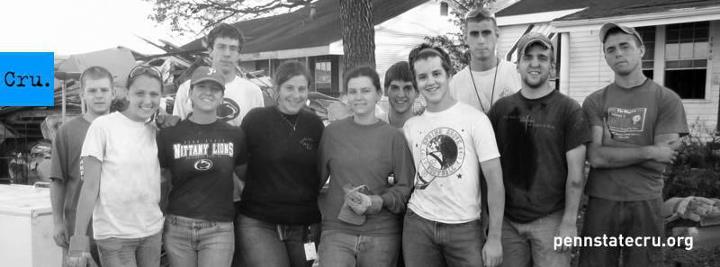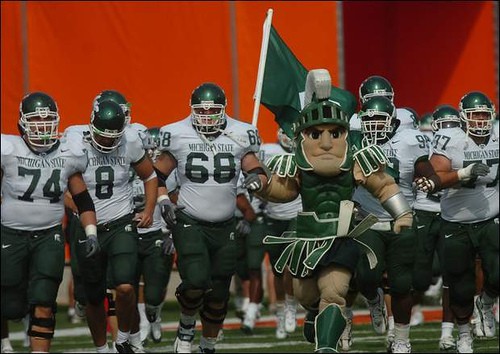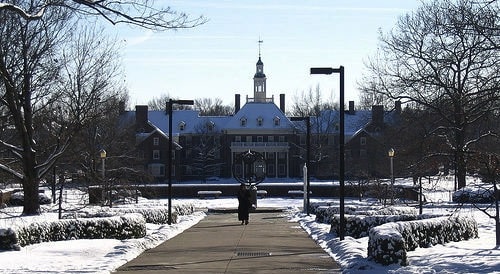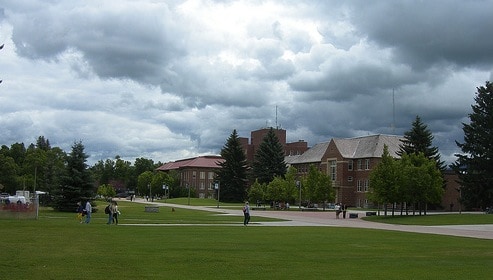This is part of a series: Learning from Large Cru Movements- a look at 8 of the largest Cru movements in the U.S.  Read the Series intro here.
This post is a summary of two conversations I had with Tim Henderson — in Summer of 2008 and 2011. So some of the content may not 100% reflect the current reality at Penn State Cru. But it’s such good stuff, it is worth sharing all of it.
Overview of the Movement at Penn State
Movement stats as of 2011
- There are 44,000 students enrolled at Penn State
- 300-400 students involved in Cru (maybe 5% growth every year)
- Been pretty slow growth the whole way
- 8-14 people are coming on every year into Cru internships and staff
- About 500 students at weekly meeting (ranging from 275-600);
- 24 small group Bible Studies
- Staff team ranges from 10-13
- Aside:To my knowledge, Tim Henderson is the most innovative Cru Director in the nation.
- He has produced phenomenal resources like the Compass and Cru.comm (which, I would guess played a role in eventually forming the phenomenal CruPressGreen).
- About a decade ago Penn State brought in a graphic designer to come up with a brand for their ministry (and many Cru ministries, especially in the Northeast, have used this branding)
- They wanted to reach drunks so they came up with the “Beer is Proof” Evangelistic campaign (that many campuses have used)
- He led the research team that delivered the very insightful Changing Evangelism report (that is well worth reading if you want to understand how to better reach today’s college students)
- He wrote/gave a brilliant talk to the Penn State Cru movement following the news on Sandusky in Fall 2011.
- Penn State Cru is always on the cutting edge on evangelism and really college ministry in general.
What we do
- We are not an evangelistic organization
- We are not a discipleship organization
- We are a labor producing factory — our clarion call — this would be my message if I had a megaphone
- I always ask the staff:
- If we were a factory, what is the widget we would produce?
- If we were a tree, what would be our fruit?
- Laborers!
- We make missionaries
- Our raw good is lost students
- Process is centering them on Christ
- Churn out laborers (missionaries — don’t care who they work for)
- We win and build so that we can send
- Why do we share the gospel?
- B/c out there, among the lost, are people who will be laborers
- This is what we do
What does evangelism look like on your campus?
- There are 2 types of students:
- The ready and the unready
- Doug Pollock in his book God Space says that evangelism is like golfing:
- You need to be able to drive, putt, chip
- I think a lot of time Cru treats it like it’s a putting game
- But most people are not on the green
- We’re using Community to address Evangelism effectiveness
- We’re doing a big experiment on how to not have evangelism suck
- We read Tim Downs Finding Common Ground and Randy Newman’s Questioning Evangelism books
- We had our staff team read Carnegie’s How to Win Friends and Influence People
- [Here at Arkansas we use Penn State’s Community 2:8 strategy for evangelism. It’s simple and effective.]
- Evangelism Made Slightly Less Difficult is the best book I’ve read on evangelism recently
Ministry Structure
In 2009 we restructured everything that we do here.
We made sweeping changes because:
- We need to penetrate far more of the campus with the gospel
- We need to dramatically increase our capacity to love and serve students
- We need to build better bridges to life and ministry after graduation
- We have heard from far too many of our grads that the sudden transition from the considerable support structures they experienced in Cru to the independence and relative isolation of the “real world” has been jarring. Indeed, too many of our grads cease influencing others for Christ, and worse still others stop walking with Christ at all.
These two documents describe some of the changes we made— What is Cru, Transition Letter to Students.
Everything we do is designed to move students toward becoming:
“independent, capable, Christ-centered laborers equipped and motivated to continue their own development and influence the world for Christ”
We have Four Lanes that students can lead in:
- Managers(organizationally minded)
- Managers run the infrastructure of Cru. If you like to set direction, strategize, plan, and execute those plans this lane is for you.
- Bonus side effect — Penn State does really good job at recruiting to Ops
- Multipliers— evangelists and discipleship
- They lead our dozens of small group Bible studies across campus, and meet weekly with students one-on-one to help them walk, communicate, and multiply their faith.
- Freshmen team—
- The Freshman team exists to reach every freshman at Penn State
- Always composed of sophomores (6-8 student leaders who oversee the Multipliers who lead freshmen studies)
- Freshmen bible studies are all led by sophomores
- Missionaries —if you don’t want to be burdened with a group and want to just go after new areas (you can read more about this lane here) — link to changing evangelism
- In general for leaders: Quality proceeds quantity
- Our students are particularly sharp leaders
Weekly Meeting
- The entry point to the movement
- Being in a consistent place with a great location is huge
- Most people come b/c a friend invited them
- Community is our primary currency
- We work really hard to make sure we have a meeting that people want to bring their friends to (feel comfortable with)
- We are seeker-friendly but with pretty deep talks, pretty serious worship
- 3 things we focus on:
- Good Worship
- Good teaching
- Fun (not embarrassing)
- Students speak at Cru 2-3 times a year — big win
Bible Studies
- Freshmen bible studies are led by Sophomores who lead in pairs—
- Not sure how many are in studies because that’s someone else’s job to know that!
- Maybe 12 freshmen studies?
- This year we’re trying to have fewer, bigger studies
Discipleship
- “Discipleship” has at least two senses.
- The general biblical sense that pertains to all of our life as followers of Christ
- And the Crusade sense of “discipleship proper” by which we mean a one hour meeting each week in the student union with an older student or staff member.
- In Crusade we tend to use it almost exclusively in the more limited sense.
- We hope to recast discipleship in the broader sense, while continuing to value the particular sense known around here as “D Time.”
- In doing so we hope to help our students learn to see the many, many ways that they can participate in the act of growing as a disciple of Christ, now.
- Also, we hope the variety will help them be prepared to find the discipleship in its many forms after graduation
- [You can read more in the two documents linked to above re: the changes they made]
What do staff focus on?
- We get out of the way and let students lead
- If our students are going to lead, what does that leave us to do?
- 3 things:
- Set direction (“this is where we are going”)
- Resource (skills, tools, money)
- Develop
We are asking Staff to lead at a much higher level.
- Our Staff all specialist- they all work exclusively in their lanes and lead it as a Director
- One person leads each of the Lanes (It’s like having 4 Directors)
- Everything happens within those lanes
- They disciple within those lanes
- Tom leads Multiplier lane
- He cares and develops everyone in his lane
- Weekly meeting with everyone
- Indiv meeting with each student (not every one every week)
- Not necessarily discipleship (one on one)
- Where they share their faith and talk about their girlfriend
- Missionaries
- Mostly just going and doing Perspectives Cards
- Every three weeks rotate thru guys (taking them out)
- Managers — take them sharing twice a semester
- We coach the student team leaders
- How did the weekly meeting go?
- What is going on in your life?
- Students lead their own team — staff don’t go to the team meetings
- It’s the staff’s job to lead the student leaders; the student leaders’ job is to lead their team (CRU, prayer, etc.)
- We coach the student team leaders
- Our Staff has invested really heavily in doing the 5 follow ups
- We call it “Cru core values” and we heavily promote it:
- “If you’re a freshman and you’re new, we’d love to go through this one on one with you”
- Have them sign up to meet and talk about our Cru core values
- It’s the best thing we do for evangelism
- We call it “Cru core values” and we heavily promote it:
What do you (the Director) focus on?
- My job is to keep my staff happy so they’ll stick around and grow up to be Directors
- I speak every other week at our weekly meeting
- Lead missionary lane
- Meet every week with them (45 students)
- Develop the team
- Meet one-on-one with staff
- I never go on campus alone
- Always with staff or student
- Weekly schedule
- In the office all day Monday
- Wed. AM prep morning
- Thursday afternoon prepping for Talks
- Other mornings, doing staff meeting or training
Making Staff Happy
- We go out early to Ray’s Town (where we have our leadership retreat)
- We get a houseboat for our staff
- We invest very heavily in making our staff really happy
- Play a ton together
- We do a lot of staff retreats
- Strong sense of camaraderie
- One year we took off the week after Fall Retreat
- Monday and Tuesday off
- Wednesday — day of prayer
- Thursday night — cheese and chocolate fondue for the students (at a mansion house they rented for dirt cheap)
- Took the staff team to Philadelphia on Friday
- Net effect= staff are feeling: “I went a whole week, I celebrated, we played, I left town, and now I’m ready to go hard for the rest of the semester”
Miscellaneous
Question — You’ve referred to community a lot; how that is your primary currency, the main thing you do.
How do you produce good, life-changing community?
- We talk about it incessantly
- Applaud it when it happens
- Spend money on it
- Make things as fun and social as we can
- Staff team loves each other — we play a lot
- A sense of playfulness that permeates our movement
- Dances and socials
- Houses where students throw parties
- Videos during Cru to promote their parties
- Lodgefest — bunch of guys lived at a place called the Lodge
- At beginning of the year, take all the leaders down to a lake
- For 3 days
- Water ski, jump off cliffs
- Camp fires
- Live in tents
- Evangelism training
- Drenched in community and play
- Turn everything into a C2:8 event
- Cru Meetings aren’t too formal
- We’re here to have a good time and verbalize that
- Champion inclusivity and warmth
Recruiting
We’re trying to get as many kids to join our staff as we can
- We need more laborers and are current system won’t give us any more (if we wait for staff)
- We tell students:
- “There is no one better than a Penn State Cru senior to go reach other Penn State students.”
- There’s a ton of people in our movement who won’t go on to do full time ministry but might invest a year with us
- We’re going to run a campaign called, “One year and then career”
- Result would be another 5-10 laborers per year who will in turn give us more potential to do more
Strategic Planning
We use a framework called Clouds and Puzzles Pieces (click to see the pdf of the framework)
4 questions
1) What are we trying to build here this year?
- What are we trying to get done/accomplished? Mission/Vision
2) What are the problems holding us back?
3) What do we currently have that can help us?
- Critical mass
- Your weekly meeting is not a problem to be solved
- It’s a bucket of cash
- We use our weekly meeting to help our morale problem
- We use our weekly meeting to fix community
- We have 400 people that are a resource
4) How do we spend what we have to solve our problems, meet our goals, and increase what we have for next year and its problems?
Example:
- Couldn’t get kids to come to a ministry training time
- Don’t want to come because it’s boring, time constraints
- There is no time where we can do training time during the year
- We bought a bunch of tents and booked a couple nights at Ray’s Town camp
- Did it before the school year
- Charged $30
- Train them up and have a blast
- Ray’s Town (training we do before the year) is no longer a problem, it’s a resource, it’s critical mass we can use for our purposes
- Students are trained, have fun, connect with each other
Those 4 questions are  the framework that we work through
[Here at Arkansas we’ve adapted this approach and use it for all of our planning — I wrote more in depth about it here]
On Sharing Resources
- We never make things intending to use it nationally
- All we do is make things we need
- We needed something for discipleship, so we came up with the Compass
- We needed something to use for drunks so we made Beer is Proof
- It only took 5% more effort to share the wealth
- We made Cru.comm (Bible study material) because we lacked control over small group material and that was hurting our sending
- We would ask students to join them on staff and they would be like, “why?” – they had no idea what we were about, our distinctives
- We wanted material where we knew our students would be getting our distinctives over 2-3 years in Cru
- 80% of our small groups use Cru.comm




